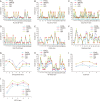Readability assessment of commonly used urological questionnaires
- PMID: 30182074
- PMCID: PMC6121017
- DOI: 10.4111/icu.2018.59.5.297
Readability assessment of commonly used urological questionnaires
Abstract
Purpose: This study was performed to assess readability of the most commonly used questionnaires in urology including a separate analysis of their single-items to identify questions that might be especially demanding for patients.
Materials and methods: The guidelines of the European Association of Urology were screened for recommended questionnaires. Readability was analyzed for complete questionnaires as well as their single-items separately using well established readability assessment tools, including Flesch-Kincaid grade level (FKGL), Simple Measure of Gobbledygook grade level (SMOG), Coleman-Liau Index (CLI), Gunning-Fog Index, and the Flesch Reading Ease formula.
Results: A total of 13 questionnaires were included to the analysis. Calculation of grade levels (FKGL, SMOG, CLI, FGI) showed readability scores of 2.7th to 16.7th grade. Easiest readability as calculated by median grade levels was found for the short form of the International Consultation on Incontinence Questionnaires-Female Lower Urinary Tract Symptoms short form (FLUTS-SF) while the short form of the International Index of Erectile Function (IIEF-5) showed the hardest readability. Based on the FKGL between 0% (FLUTS-SF) and 80% (IIEF-5) of the single-items were written above the recommended grade levels.
Conclusions: The questionnaires that are used most frequently in urology mainly show a satisfactory overall readability. Inadequate readability levels were not only found for individual questionnaires but also for single-items of the majority of assessed questionnaires. This requires consideration for the interpretation of results and when developing novel health-related surveys.
Keywords: Comprehension, reading; Surveys and questionnaires; Urology.
Conflict of interest statement
CONFLICTS OF INTEREST: The authors have nothing to disclose.
Figures




References
-
- Kasabwala K, Agarwal N, Hansberry DR, Baredes S, Eloy JA. Readability assessment of patient education materials from the American Academy of Otolaryngology--Head and Neck Surgery Foundation. Otolaryngol Head Neck Surg. 2012;147:466–471. - PubMed
-
- Medlineplus. How to write easy-to-read health materials [Internet] Bethesda (MD): U.S. National Library of Medicine, U.S. Department of Health and Human Services National Institutes of Health; [updated 2017 Jun 28]. [cited 2018 Jan 15]. Available from: https://medlineplus.gov/etr.html.
-
- Weiss BD. Health literacy and patient safety: help patients understand. Manual for clinicians. 2nd ed. Chicago (IL): American Medical Association, American Medical Foundation; 2007.
-
- Bergman J, Gore JL, Singer JS, Anger JT, Litwin MS. Readability of health related quality of life instruments in urology. J Urol. 2010;183:1977–1981. - PubMed
MeSH terms
LinkOut - more resources
Full Text Sources
Other Literature Sources
Research Materials
Miscellaneous

